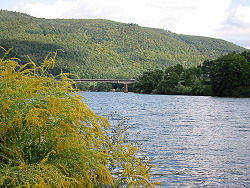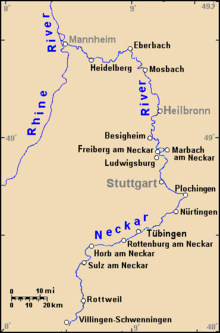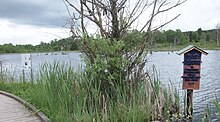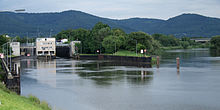Neckar
Neckar
Jump to navigation
Jump to search
| Neckar | |
|---|---|
 The Neckar near Heidelberg | |
| Country | Germany |
| Physical characteristics | |
| Main source | Black Forest 706 m (2,316 ft) |
| River mouth | Rhine 49°30′43″N 8°26′14″E / 49.51194°N 8.43722°E / 49.51194; 8.43722Coordinates: 49°30′43″N 8°26′14″E / 49.51194°N 8.43722°E / 49.51194; 8.43722 |
| Length | 362.4 km (225.2 mi) [1] |
| Discharge |
|
| Basin features | |
| Basin size | 13,928 km2 (5,378 sq mi) [1] |
The Neckar (German pronunciation: [ˈnɛkaɐ̯] (![]() listen)) is a 362-kilometre-long (225 mi) river in Germany, mainly flowing through the southwestern state of Baden-Württemberg, with a short section through Hesse. The Neckar is a major right tributary of the Rhine. Rising in the Black Forest near Villingen-Schwenningen in the Schwenninger Moos conservation area at a height of 706 m (2,316 ft) above sea level, it passes through Rottweil, Rottenburg am Neckar, Kilchberg, Tübingen, Wernau, Nürtingen, Plochingen, Esslingen, Stuttgart, Ludwigsburg, Marbach, Heilbronn and Heidelberg, before discharging into the Rhine at Mannheim, at 95 m (312 ft) above sea level.
listen)) is a 362-kilometre-long (225 mi) river in Germany, mainly flowing through the southwestern state of Baden-Württemberg, with a short section through Hesse. The Neckar is a major right tributary of the Rhine. Rising in the Black Forest near Villingen-Schwenningen in the Schwenninger Moos conservation area at a height of 706 m (2,316 ft) above sea level, it passes through Rottweil, Rottenburg am Neckar, Kilchberg, Tübingen, Wernau, Nürtingen, Plochingen, Esslingen, Stuttgart, Ludwigsburg, Marbach, Heilbronn and Heidelberg, before discharging into the Rhine at Mannheim, at 95 m (312 ft) above sea level.
From Plochingen to Stuttgart the Neckar valley is densely populated and industrialised, with several well-known companies, e.g. Daimler AG (the maker of Mercedes Benz cars) and Mahle GmbH being located there. Between Stuttgart and Lauffen the Neckar cuts a scenic, meandering, and in many places steep-sided, valley into fossiliferous Triassic limestones and Pleistocene travertine. Along the Neckar's valley in the Odenwald hills many castles can be found, including Hornberg Castle and Guttenberg Castle in Haßmersheim; the now-mothballed Obrigheim Nuclear Power Plant and the active Neckarwestheim Nuclear Power Plant are also located there. After passing Heidelberg, the Neckar discharges on average 145 m3/s (5,100 cu ft/s) of water into the Rhine, making the Neckar its 4th largest tributary, and the 10th largest river in Germany. From about 1100 Black Forest timber was rafted downstream as far as Holland, for use in shipyards.
The name Neckar might be derived from Nicarus and Neccarus from Celtic Nikros, meaning wild water or wild fellow. The grammatical gender of the name in German is masculine (Der Neckar).
During the 19th century, traditional horse-drawn boats were replaced by steam-powered chain boats that used a 155 km (96 mi) long chain in the river to haul themselves upstream towing barges. After 1899 a railway made it possible to transport timber to the port of Heilbronn, limiting timber rafting to the lower part of the Neckar. Due to the construction of 11 locks, ships up to 1500 t could travel to Heilbronn in 1935.

The Neckar in southwest Germany flows from south to north, and joins the Rhine at Mannheim.

The source of the Neckar, the Schwenninger bog

Water reflection of houses in Tübingen reflected in the Neckar

A Stocherkahn (poled boat) on the Neckar in Tübingen

The Neckar in Stuttgart

The Neckar near Neckarsulm
By 1968 the last of 27 locks, at Deizisau, was completed, making the Neckar navigable for cargo ships about 200 kilometres (120 mi) upstream from Mannheim to the river port of Plochingen, at the confluence with the Fils, and where the Neckar bends, taking a northwesterly instead of a northeasterly course. Other important ports include Stuttgart and Heilbronn.
The river's course provides a popular route for cyclists, especially during the summer months. Its steep valley sides are used for vineyards, mainly for the cultivation of Trollinger, Lemberger, Kerner, Müller-Thurgau amongst other locally grown grape varieties..
The name "Neckar" was also given to the world's first motorboat made during the summer of 1886 by Gottlieb Daimler and Wilhelm Maybach when their Standuhr (grandfather clock) petrol engine was tested on the river near Bad Cannstatt.
Contents
1 Towns
2 Main tributaries
3 Bridges
4 In music
5 References
6 External links
Towns[edit]
From its source to its confluence with the Rhine:
- Villingen-Schwenningen
- Rottweil
- Oberndorf am Neckar
- Sulz am Neckar
- Horb am Neckar
- Rottenburg am Neckar
- Kilchberg
- Tübingen
- Nürtingen
- Wendlingen
- Wernau
- Plochingen
- Esslingen am Neckar
- Stuttgart
- Remseck
- Ludwigsburg
- Marbach am Neckar
- Benningen am Neckar
- Freiberg am Neckar
- Besigheim
- Lauffen am Neckar
- Heilbronn
- Neckarsulm
- Bad Wimpfen
- Mosbach
- Eberbach
- Neckarsteinach
- Heidelberg
- Mannheim

Old Bridge, Heidelberg

Lock on Wieblingen channel from Heidelberg and open river at Schwabenheim

confluence with the Rhine in Mannheim
Main tributaries[edit]
Eschach (left side, at Rottweil-Bühlingen)
Ammer (left side, at Tübingen-Lustnau)* Lauter (right side, at Wendlingen)
Fils (right side, at Plochingen)
Körsch (left side, at the border of Esslingen to Deizisau)
Nesenbach (left side, at Stuttgart-Ost)
Rems (right side, at Remseck)
Murr (right side, at Marbach)
Enz (left side, at Besigheim)
Zaber (left side, at Lauffen)
Sulm (right side, at Neckarsulm)
Kocher (right side, at Bad Friedrichshall)
Jagst (right side, at Bad Wimpfen)
Elz (right side, at Mosbach-Neckarelz)

Bridges[edit]
Neckar Valley Bridge Weitingen, near the town Horb am Neckar.
Old Bridge, in Heidelberg
In music[edit]
The Neckar is mentioned prominently in Gustav Mahler's "Rheinlegendchen" ('Little Rhine Legend'), composed in August 1893. "Rheinlegendchen" was first published in 1899 in a cycle of 12 songs under the title Humoresken ('Humoresques'); it is today known as one of Mahler's Songs from Des Knaben Wunderhorn (Songs from The Youth's Magic Horn),
References[edit]
^ ab Map services of the Baden-Württemberg State Office for the Environment, Survey and Conservation (Landesanstalt für Umwelt, Messungen und Naturschutz Baden-Württemberg)
External links[edit]
| Wikimedia Commons has media related to Neckar. |
- Neckar online water guide
- Old Town Heidelberg on the river Neckar
Tourism Information about the river Neckar (German)
Categories:
- Neckar basin
- Rivers of Baden-Württemberg
- Rivers of Hesse
- Federal waterways in Germany
(window.RLQ=window.RLQ||).push(function()mw.config.set("wgPageParseReport":"limitreport":"cputime":"0.344","walltime":"0.815","ppvisitednodes":"value":1464,"limit":1000000,"ppgeneratednodes":"value":0,"limit":1500000,"postexpandincludesize":"value":40416,"limit":2097152,"templateargumentsize":"value":6791,"limit":2097152,"expansiondepth":"value":15,"limit":40,"expensivefunctioncount":"value":5,"limit":500,"unstrip-depth":"value":0,"limit":20,"unstrip-size":"value":1036,"limit":5000000,"entityaccesscount":"value":1,"limit":400,"timingprofile":["100.00% 688.009 1 -total"," 58.97% 405.696 1 Template:Infobox_river"," 55.02% 378.511 1 Template:Infobox"," 29.07% 199.976 1 Template:Coord"," 5.41% 37.254 10 Template:Convert"," 5.22% 35.940 1 Template:Authority_control"," 5.01% 34.440 1 Template:Other_uses"," 2.46% 16.952 1 Template:Commons"," 2.13% 14.644 1 Template:Sister_project"," 2.05% 14.135 1 Template:Rhine_Tributaries"],"scribunto":"limitreport-timeusage":"value":"0.139","limit":"10.000","limitreport-memusage":"value":5176101,"limit":52428800,"cachereport":"origin":"mw1267","timestamp":"20180826155715","ttl":1900800,"transientcontent":false);mw.config.set("wgBackendResponseTime":106,"wgHostname":"mw1320"););


 Clash Royale CLAN TAG
Clash Royale CLAN TAG